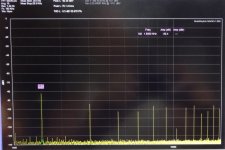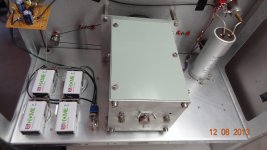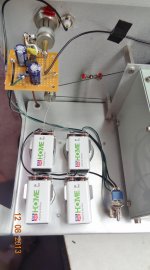Fundemental supression-
Same as above except input is 1.5KHz (meter out of circuit). Suppressed fund. is seen... that is about right I think.
[How good the null is depends on how good I nulled it and drift before capture the screen. To get best and most stable null.... the 334A needs to be on for hours. The inside temp is warm and stable by that time and a best null an be obtained.]

THX-RNMarsh
Same as above except input is 1.5KHz (meter out of circuit). Suppressed fund. is seen... that is about right I think.
[How good the null is depends on how good I nulled it and drift before capture the screen. To get best and most stable null.... the 334A needs to be on for hours. The inside temp is warm and stable by that time and a best null an be obtained.]

THX-RNMarsh
Last edited:
I have been seeing changes in level of the harmonics at low distorton levels with low cost ADC based test equipment; The 2H and 3H change with input level when the input source isnt changing it harmonics.
there is another uncorrected 2H level change and it depends on the notch filter Q/depth. The notch affecting the level of the 2H. In the case of the 334A, a change in the depth of the notch by 10dB caused a change in the 2H of 4dB.
The auto-null affects the notch depth and thus the 2H as well. That is, the manual null vs auto null produces different notch performance with the 334A (and maybe others) and the result is the detected level of 2H is affected.
These sort of things need to be nailed down.... rather than assume what you see is what the DUT does.
Thx-RNMarsh
there is another uncorrected 2H level change and it depends on the notch filter Q/depth. The notch affecting the level of the 2H. In the case of the 334A, a change in the depth of the notch by 10dB caused a change in the 2H of 4dB.
The auto-null affects the notch depth and thus the 2H as well. That is, the manual null vs auto null produces different notch performance with the 334A (and maybe others) and the result is the detected level of 2H is affected.
These sort of things need to be nailed down.... rather than assume what you see is what the DUT does.
Thx-RNMarsh
Last edited:
Re HP-334A: I reassigned the Norm-RF Det switch located just above the Input port so it will only disconnect the meter and reconnect the meter. I can now tune for null in Normal position and then disconnect the meter for lower distortion. It is fast and easy to get to.
Thx-RNMarsh
Thx-RNMarsh
Last edited:
It looks to be possible to use the HP-334A as a tunable notch filter for use with ADC/FFT hardware IF the various descrete amplifier circuits can be replaced with modern opamps of very low distortion. Unfortunately, the original design used single-end, cap coupled circuits which produce a lot of 2H and beyond - making the circuits pretty much not significantly upgradable. Just need to be replaced. That is more than I need to do at this time.
I am still interested in a notch filter which is variable and has an auto-null to lock it as a more practicle next step for this subject.
Right now, the passive B&K 1607 notch filter is distortion free and with a mod to make it active, gets the job done. But, it is not auto-null. With high Q circuits, you need to be kept within .1% of the signal freq to have accurate harmonic data results. Keeping it there is where the auto-null help comes in.
Thx-RNMarsh
I am still interested in a notch filter which is variable and has an auto-null to lock it as a more practicle next step for this subject.
Right now, the passive B&K 1607 notch filter is distortion free and with a mod to make it active, gets the job done. But, it is not auto-null. With high Q circuits, you need to be kept within .1% of the signal freq to have accurate harmonic data results. Keeping it there is where the auto-null help comes in.
Thx-RNMarsh
Last edited:
Just to clarify for those who haven't used these things but are interested -- if you are looking at the output of the notch filter with a spectrum analyzer, either hardware like a Tek 7L5 or with a sound card and software, then the fundamental signal does not need to be completely notched out -- a 40dB notch is easy to obtain and reduces the problem of self-distortion from the sound card's ADC to nearly negligible amounts, leaving other ADC factors as limits, like noise.
However, if reading THD on a meter, then the fundamental null of the notch filter has to be a lot lower in level than the distortion products, and for this, auto-null is absolutely needed, and it needs to be real good if you expect to see results under 10ppm/-110dB, which is about the best resolution the HP 339 can do. The 339's fundamental null can run to -115dB, or even much more as several here have determined through parts changes. But fundamental null and noise are two of the largest limiting factors for a THD meter reading.
However, if reading THD on a meter, then the fundamental null of the notch filter has to be a lot lower in level than the distortion products, and for this, auto-null is absolutely needed, and it needs to be real good if you expect to see results under 10ppm/-110dB, which is about the best resolution the HP 339 can do. The 339's fundamental null can run to -115dB, or even much more as several here have determined through parts changes. But fundamental null and noise are two of the largest limiting factors for a THD meter reading.
I got interested in the notch during the 339A oscillator distortion reduction journey. I tried the B&K1607 on the 2H and the 3h to deduce the remaining residual into the noise floor. it worked well for that purpose also.
The 339A does not have enough adjustment flexibility to get null at each selected freq so the distortion is a compromise over the wide range of freqs. The 339A can be tuned into the noise but only for 1 or 2 freqs at a time. So the variable notch takes care of that at the source. If I tune the 339A for min 3H, I notch out the remaining 2H... or visa-versa.....all the other harmonics are too low to cae about. The Krone-Hite 4402B is a better source however. Easier to get ultra low distortion at all freqs but without the other built-in features of the 339A.
Then I found Vicktors individual oscillators on eBay came into being and they are individually optimized for one freq. So, several of those is another option for low cost ultra low distortion source. Now its onto the measuring of the distortion at ultra low source distortion levels. Where a notch is used with ADC/FFT. Davada turned us onto the QA400. But for the area below -100dB, sometimes a more flexable notch (variable) filter with auto-tune would be a nice additional feature.
-RNMarsh
The 339A does not have enough adjustment flexibility to get null at each selected freq so the distortion is a compromise over the wide range of freqs. The 339A can be tuned into the noise but only for 1 or 2 freqs at a time. So the variable notch takes care of that at the source. If I tune the 339A for min 3H, I notch out the remaining 2H... or visa-versa.....all the other harmonics are too low to cae about. The Krone-Hite 4402B is a better source however. Easier to get ultra low distortion at all freqs but without the other built-in features of the 339A.
Then I found Vicktors individual oscillators on eBay came into being and they are individually optimized for one freq. So, several of those is another option for low cost ultra low distortion source. Now its onto the measuring of the distortion at ultra low source distortion levels. Where a notch is used with ADC/FFT. Davada turned us onto the QA400. But for the area below -100dB, sometimes a more flexable notch (variable) filter with auto-tune would be a nice additional feature.
-RNMarsh
Last edited:
I followed up on a discussion here http://www.diyaudio.com/forums/lounge/200865-sound-quality-vs-measurements-1019.html#post3592892 on cancelling harmonics caused by agc circuits. I feel I'm crossposting almost but its relevant here and in the oscillator thread.
What is the value of the coupling cap that is producing the 2rd H ?It looks to be possible to use the HP-334A as a tunable notch filter for use with ADC/FFT hardware IF the various descrete amplifier circuits can be replaced with modern opamps of very low distortion. Unfortunately, the original design used single-end, cap coupled circuits which produce a lot of 2H and beyond - making the circuits pretty much not significantly upgradable. Just need to be replaced. That is more than I need to do at this time.
I am still interested in a notch filter which is variable and has an auto-null to lock it as a more practicle next step for this subject.
Right now, the passive B&K 1607 notch filter is distortion free and with a mod to make it active, gets the job done. But, it is not auto-null. With high Q circuits, you need to be kept within .1% of the signal freq to have accurate harmonic data results. Keeping it there is where the auto-null help comes in.
Thx-RNMarsh
What is the value of the coupling cap that is producing the 2rd H ?
There are several and they are electrolytics. However, the single-ended transistor topology is perhaps a worse offender. Together it is not going to easily serve my needs. Too bad, because it is wonderfully built and reliable work-horse. it still beats the published specs by 50% !!
[if only the 339A had been made as well :-( ]
Thx-RNMarsh
There are several and they are electrolytics. However, the single-ended transistor topology is perhaps a worse offender. Together it is not going to easily serve my needs. Too bad, because it is wonderfully built and reliable work-horse. it still beats the published specs by 50% !!
[if only the 339A had been made as well :-( ]
Thx-RNMarsh
Hi Rick,
Bob's SV auto null notch filter from his analyzer might be worth looking into.
And there is the SYS1 as well.
I have a 331a and was going to look in to it . ThanksThere are several and they are electrolytics. However, the single-ended transistor topology is perhaps a worse offender. Together it is not going to easily serve my needs. Too bad, because it is wonderfully built and reliable work-horse. it still beats the published specs by 50% !!
[if only the 339A had been made as well :-( ]
Thx-RNMarsh
Hi Rick,
Bob's SV auto null notch filter from his analyzer might be worth looking into.
And there is the SYS1 as well.
I loaned (gave away, probably) my dual domain SYS 1 to friends in Thailand. But that reminds me, there are a lot of SYS One's on eBay now and they are a good deal for anyone.
Still looking for the quick and easy way out... an auto-null notch I (and other's) can buy and use or modify. Not into scratch building test equipment anymore. But maybe I could stand it if I had to just stuff a pcb, perhaps.
The IMD option just arrived today for the new Audio-Precision 2722. That will occupy some time for awhile, then read the manuals and load the software and start to see how to run the beast. Then I'll use it and the ShibaSoku to characterize the QA400 and others for accuracy etc at low levels of distortion. Then we'll have some idea of how trust worthy they are <-100dB and under what conditions or limitations.
Then do it with the notch filter I have on a pcb from Larry (the good guy) and check it all again.
Thx-RNMarsh
Thx-RNMarsh
B&K 1607 Activated -
Here is a variable notch filter which is passive (no distortion) and made switchable to active (very tiny distortion) which eliminates the need for correction or fudge-factoring the 2H by increasing Q of the notch filter. The low output Z helps interfacing as well. This is shown in more detail on the short B&K 1607 discussion.
Battery powered and switchable active/passive and a ten turn balance control for even finer tuning.
Now, how do I apply that auto-tune circuit to it?
THX-RNMarsh
 [BTW - all 1607's wiring is solid silver and all tuning/null caps are Polystyrene film and variable air cap. Very High Q and low distortion.]
[BTW - all 1607's wiring is solid silver and all tuning/null caps are Polystyrene film and variable air cap. Very High Q and low distortion.]

Here is a variable notch filter which is passive (no distortion) and made switchable to active (very tiny distortion) which eliminates the need for correction or fudge-factoring the 2H by increasing Q of the notch filter. The low output Z helps interfacing as well. This is shown in more detail on the short B&K 1607 discussion.
Battery powered and switchable active/passive and a ten turn balance control for even finer tuning.
Now, how do I apply that auto-tune circuit to it?
THX-RNMarsh
 [BTW - all 1607's wiring is solid silver and all tuning/null caps are Polystyrene film and variable air cap. Very High Q and low distortion.]
[BTW - all 1607's wiring is solid silver and all tuning/null caps are Polystyrene film and variable air cap. Very High Q and low distortion.] 
Last edited:
Here is a variable notch filter which is passive (no distortion) and made switchable to active (very tiny distortion) which eliminates the need for correction or fudge-factoring the 2H by increasing Q of the notch filter. The low output Z helps interfacing as well. This is shown in more detail on the short B&K 1607 discussion.
Battery powered and switchable active/passive and a ten turn balance control for even finer tuning.
Now, how do I apply that auto-tune circuit to it?
THX-RNMarsh
View attachment 365533 [BTW - all 1607's wiring is solid silver and all tuning/null caps are Polystyrene film and variable air cap. Very High Q and low distortion.]
View attachment 365534
The least intrusive would be to use a mechanical servo on the tuning cap. But you still need to measure the relative phase. I'm just reading up on phase measurement. It's clunky but wouldn't add to the distortion. You could take the output of a vector voltmeter to drive the servo. This would work very well if you don't mind a lot of outboard gear. If you want a neat little package then never mind.
Lot's of vector voltmeters on Ebay for cheep.
I'm not sure you really need the "afc" to get value from the filter. The oscllator will drift and the filter will drift but you are not using it as a classic distortion analyzer to remove the fundamental, just to reduce it 20-40 dB to extend the useful range of an FFT.
It practice a few manually tuned notch filter modules matched to a few of Victor's oscillators could be all that is necessary to get SOTA measurements from a QA400. The Twin T plus feedback and 20 dB of gain should be ideal for the task. 40 dB of post filter gain and an HP333 or HP334 may be able to see that deep? (I think we went down this road a year ago?) if we limit the actual notch depth to 40 dB w/ 40 dB of gain it become usable with almost any distortion analyzer.
It practice a few manually tuned notch filter modules matched to a few of Victor's oscillators could be all that is necessary to get SOTA measurements from a QA400. The Twin T plus feedback and 20 dB of gain should be ideal for the task. 40 dB of post filter gain and an HP333 or HP334 may be able to see that deep? (I think we went down this road a year ago?) if we limit the actual notch depth to 40 dB w/ 40 dB of gain it become usable with almost any distortion analyzer.
Yes, i believe this to be trrue as well. I have a variety of source/generators however and find the flexibility useful for a variety of tests and apps. It can be applied in many other areas of T&M. I think the B&K 1607 with the active mod is just fine for me. Guilding the lilly with auto-tune, I suppose.
Next, i have a chassis here that I am about to drill and mount several of Vicktor's generators in it. Just in case my 'loaner friend' takes back his great ShibaSoku source so generously lent -- becoming a long term loan. Thanks Demian for the loan.
THX-RNMarsh
Next, i have a chassis here that I am about to drill and mount several of Vicktor's generators in it. Just in case my 'loaner friend' takes back his great ShibaSoku source so generously lent -- becoming a long term loan. Thanks Demian for the loan.
THX-RNMarsh
I think I'll test the idea that I can increase the open-loop gain of the amps in the HP-334A with active loads - replacing the gain stage load resistor(s). Curious how much imrovement is found that way... easier and simpler than whole redesign/replacement.
-RM
-RM
Last edited:
- Status
- This old topic is closed. If you want to reopen this topic, contact a moderator using the "Report Post" button.
- Home
- Design & Build
- Equipment & Tools
- Build -- Active Twin-T notch filter for distortion analysis